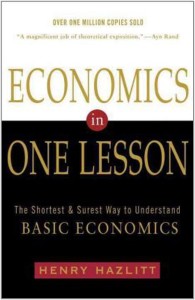
This book has been one of the most important books I’ve ever read. Many years
ago I’ve had a big thirst for knowledge with regards to economics. I wanted to
understand what politicians are talking about, when they talk about minimum
wage, inflation, deflation, price controls, exports and imports. I wanted to
know what the central bank’s purpose is and what interest rates are all about.
There was just one problem: It just seemed way too complicated.
I didn’t
understand the explanations I’ve found. It seemed as if I’d have to devote many
years of my life to a full-time academic, mathematically rigorous study of
economic theory, if I ever wanted to attain a satisfying degree of knowledge
on these issues.
This book came to my rescue. It answered many of my questions, but more
importantly it gave me a framework within which I could think about economic
problems. It gave me a tool to understand fundamental economic processes. It
helped me understand what people actually mean when they call for this or that
economic policy.
How is Hazlitts book relevant for today?
There is a popular notion, repeated over and over again in
the media, that destruction causes economic growth. They usually won’t say it
quite like that, but that’s essentially what they mean. People claim, WWII lead
America out of the Great Depression. In 2009, the German government paid people
2500€, if they scrapped their old car to buy a new one. The purpose of that
policy was to stabilize the German economy after the financial crisis.
Although Hazlitt wrote his book in 1946 and based it on Bastiat’s work in 1850,
it is just as relevant today, as it has been in the past.
What is that one lesson?
It is the lesson of seeing the unseen. It is the lesson of observing that which
never came into existence because people chose not to let it come into
existence. What does that mean?
Hazlitt begins by telling a story of a baker whose window was destroyed by
someone throwing a stone. The baker had to hire a repair man to replace the
broken window. Someone observing the scene thinks that in the end, the
destruction of the window actually accomplished something good because now the
baker paid the repair man. The repair man now has more money to spend and those
people he pays with that money will in turn have more money to spend. And so
goes the ripple effect through the whole economy. People have more money to
spend and the economy is stimulated. New things are being produced – right in
front of everyone’s eyes.
What’s overlooked? The baker’s loss of course! The so-called stimulus is no
stimulus at all because it is paid for by the baker’s loss. Overall the economy is
worse off. Let’s say the repair man buys a pair of shoes with the money he got
from the baker. What’s the state of the economy? The economy has lost a window
and gained a pair of shoes. What if the window had not been broken in the first
place? The baker would have bought a suit. What’s the state of the
economy under those circumstances? The economy would have gained a suit and
lost no window. It would have been better off overall. But we never get to see
the suit. We never get to see this better state of the economy because it
exists only in a parallel universe in which the window has not been broken.
Hazlitt introduces this concept of seeing the unseen in the first chapter and
then applies the lesson over and over again in every subsequent chapter. If you
have never heard of the broken window fallacy before and you read this book,
the world will permanently look differently to you. You will have much more
clarity of thought when looking at the issues of our time.
How is the lesson applied?
Through understanding this one lesson, you will be taught to think correctly
about things such as: Taxation, labor saving machinery, full employment, tariffs,
exports, minimum wage, inflation and saving.
Is there a correct way to think about these things? Isn’t it all up for
constant debate? If you’re asking yourself this question, you must read this book.
This is not up for debate. In fact, it is very clear, once you understand the basic lesson. It is all based on sound, logical reasoning and it is spelled out in plain English.
How to get the book
Here’s the best part: You can read it for free! Read it online here
or read the PDF. If you want to read it as a
book, buy it from amazon!
I promise, you won’t regret it.